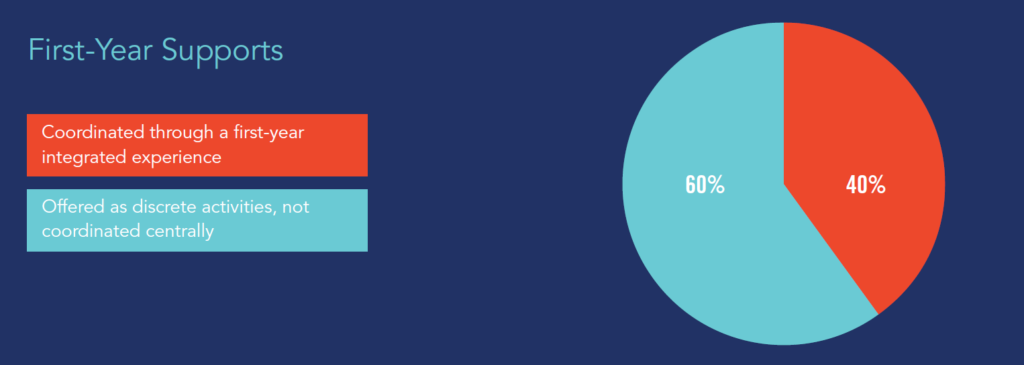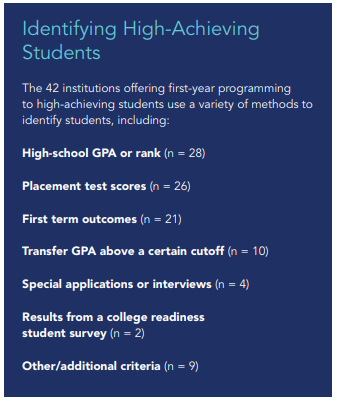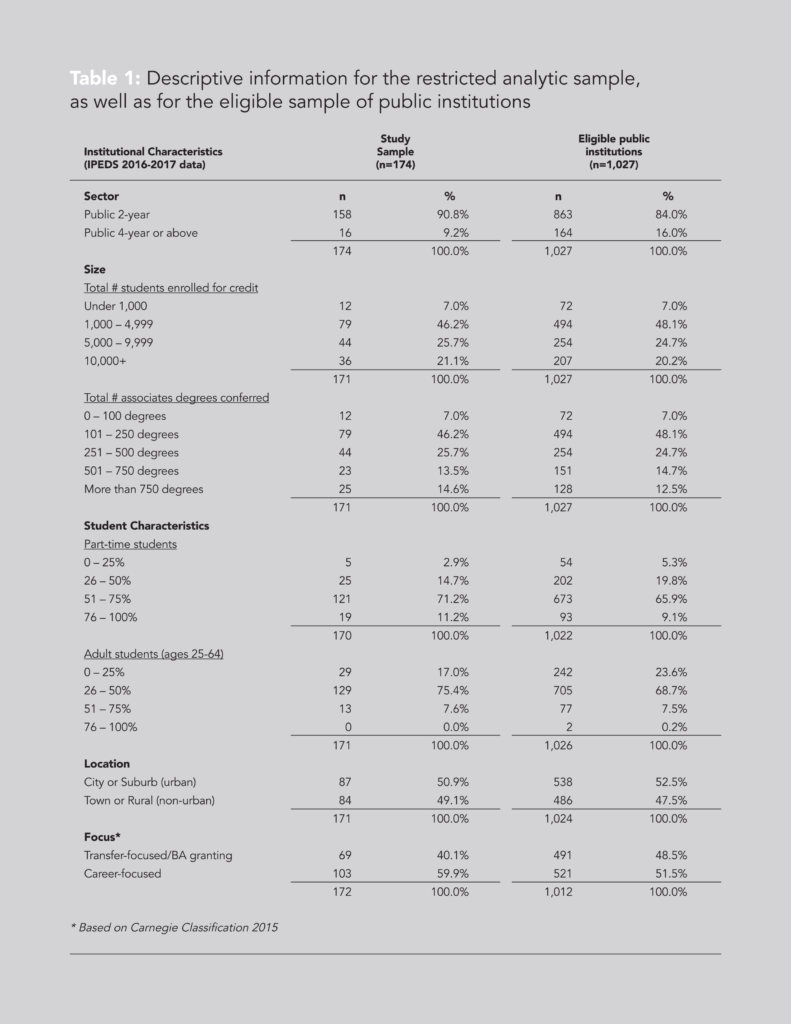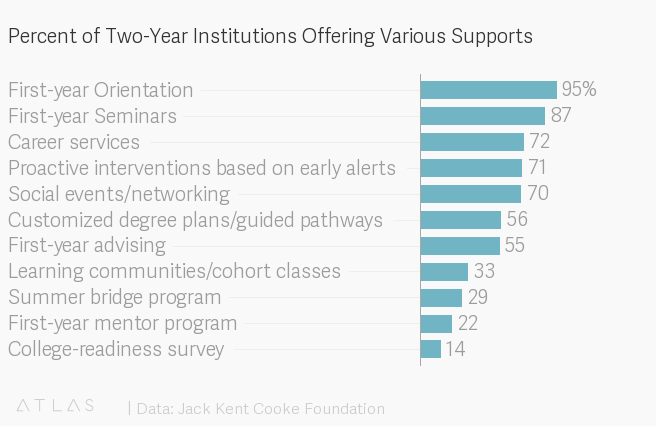First-Year Student Support: Supporting High-Achieving First-Year Students at Public Two-Year Institutions
Introduction
Students’ experiences during their first year at a higher education institution play an important role in setting them up for future success. While four-year institutions have for decades offered comprehensive services targeted to new students, two-year institutions have only more recently started to adopt these practices. The different structures, goals, and resources of associate-granting institutions, along with the non-traditional characteristics of their student body, raise questions about the transferability of first-year practices from the four-year sector and the practices two-year institutions are choosing to adopt.
Drawing on a new, national survey of public institutions that serve two-year students funded by the Jack Kent Cooke Foundation and conducted by Ithaka S+R and Two Year First Year, this research brief describes the ways that these institutions do—and do not—support students during their first year of enrollment. It also highlights the extent to which these institutions specifically support high-achieving students. Given that almost half (49 percent) of new students begin their postsecondary education at a two-year institution, it is critical that these students’ first year experiences are adequately supported.1
This brief answers two key questions:
- To what extent and in what ways do institutions offer support to first-year students in two-year programs?
- To what extent and in what ways are these supports tailored to the needs of high-achieving students?
Specifically, we examine practices pertaining to the following five areas of support for first-year students:
- First-year orientation: Programming that introduces new students to campus resources, services, and facilities and offers academic advising and course registration.
- First-year seminars: Courses that help students build social support networks, soft skills needed for the first year, and college know-how.
- Proactive advising and counseling: The opportunity to work with a dedicated professional to set academic and professional goals and follow a curricular pathway to graduate on time.
- Learning communities: A set of linked courses designed for students in the same entry cohort, degree program, or major, providing students with academic supports and a peer network of students that helps them adjust socially to college.
- Social support systems and networks: Programs or events designed to help students build meaningful peer and faculty relationships.
Appendix A describes the study’s sample and survey methodology.
Results
A total of 174 public institutions serving two-year students responded to the survey of first-year practices. Most are medium-sized (72 percent), enrolling between 1,000 and 10,000 students. Half are located in or near urban areas, and half in towns or rural areas. The majority (65 percent) are classified as serving a high proportion of career-focused students (vs. transfer-focused or bachelor-degree-seeking). Most have a student body that is majority part-time and that is at least one quarter adult-aged (i.e., 25 to 64 years).2 The institutions sampled in the present study are representative of the broader population of similar institutions in the U.S., with a slight underrepresentation of transfer-focused or bachelor-granting institutions (see Appendix A).
The most common supports offered to students in their first year are orientation, first-year seminars, career services, proactive interventions based on early alerts, and social networking opportunities (Exhibit 1). Fewer institutions offer customized degree plans, guided pathways, or first-year advising, and a minority of institutions offer learning communities or cohort classes, summer bridge programs, first-year mentoring programs, or college-readiness surveys.
Exhibit 1: Percent of Two-Year Institutions Offering Various Supports
All of the sampled institutions offer at least one of the 11 activities listed in the survey, and on average they offer six activities per institution. Most institutions (78 percent) offer between four and eight of the listed activities (Exhibit 2). Additionally, 86 percent of institutions offer accelerated or co-requisite developmental coursework, which implicitly targets new or first-year students by its design.
Exhibit 2: Number of First-Year Supports Offered at the Sampled Institutions

Number of supports offered (out of 11). For the percent of institutions, N=174.
First-Year Experience (FYE) Programs
While all institutions offer at least one type of first-year support, only 40 percent of the surveyed public institutions serving two-year students have a stand-alone first-year experience program, office, or department that is especially dedicated to helping students in the first year of a two-year degree program, or that has a similar mission.3 We identify these schools as having a First-Year Experience (FYE) program. Such programs stand in contrast with stand-alone activities that are not coordinated through a dedicated program or office. This distinction is valuable. Experts assert, and early research findings support, that combining co-curricular and non-curricular first-year student support services into intentional, comprehensive, and integrated programming across the institution and its departments improves reach and impact. By virtue of its reach across varied departments and staff members, such holistic coordinated programming can also promote an institutional culture that prioritizes first-year supports and subsequently contributes to sustainable systems change.4
Although this study does not assess the impact of FYE programs or activities, the survey findings indicate that institutions with a holistic FYE program offer more first-year activities and services, especially those that are less common in the two-year space but are backed by experimental evidence in terms of their positive impact on student outcomes at two-year institutions (e.g. mentor programs, summer bridge programs, learning communities, and accelerated developmental coursework). Institutions with FYE programs averaged seven supports, compared with an average of around five supports at other institutions.

Serving High-Achieving Students with Financial Need
Initially, we intended this report to describe ways that two-year institutions support high-achieving students with financial need during their first year. Each year, the Jack Kent Cooke Foundation Undergraduate Transfer Scholarship supports hundreds of high-achieving students with financial need who started their journey at a community college and then transferred to selective four-year institutions. These students are academically motivated and benefit from strong financial and advising supports. They often also have different motivations than other students.
Through this study, however, we found that none of the surveyed institutions offer programming that intentionally targets first-year high-achieving students with financial need. Some institutions offer first-year supports either to high-achieving students, regardless of need (24 percent), or students with financial need, regardless of academic ability (27 percent). Institutions that offer an FYE program are significantly more likely to offer programming that is targeted toward high-achieving students.
High-Achieving Students

Nearly one in four of the sampled public institutions that serve two-year students offer targeted first-year activities for high-achieving students (24 percent). Institutions use a mix of high-school academics, placement test scores, first term outcomes, or other criteria to identify students for programs (see box left).
Most of the 42 institutions with first-year programming for high-achieving students offer such programming to all their high-achieving students (81 percent), while a handful of institutions target specific subgroups of high-achieving students (e.g. first-generation students, students from minority groups, or recipients of specific scholarships). The majority offer honors programs (36 institutions) and/or provide targeted merit-based scholarships (27 institutions) to these students (Exhibit 3). Close to half (20 institutions) offer need-based scholarships or tuition/fee discounts to their high-achieving students, though not as part of a targeted program for low-income high-achieving students per se.
We note that only eight institutions offer targeted transfer-out exploration or support to high-achieving students in their first year. Similarly, only five institutions offer their high-achieving students specialized career services or supports in their first year. Academically talented students are especially well-positioned to successfully transfer to four-year institutions and excel once they do, including at the most prestigious institutions.5 They may also be especially well-positioned to pursue and secure career trajectories that yield economic benefits.6 As such, there is an opportunity for these institutions to nurture their academically talented students early on and in targeted ways. Stronger support in their first year may help students secure efficient and fulfilling post-secondary trajectories or subsequent careers that match their abilities and aspirations. Interestingly, institutions that offer an FYE program are significantly more likely to require first-year students to participate in career services, and to incorporate career-based content in their first-year seminars.
Exhibit 3: First-Year Supports for High-Achieving Students

Conclusion
The results of the national survey of public institutions that serve two-year students indicate that these institutions offer a promising array of first-year activities and services to their students, including ones that may be especially impactful in this particular space. Additionally, 40 percent of institutions appear to coordinate their first-year activities and programming in ways that may improve their reach, scale, and impact. Institutions that report offering first-year experience programs offer more activities to their students on the whole, have stronger career support offerings, and are especially likely to target supports to subgroups of underserved students.
These promising data highlight opportunities to improve supports for high-achieving first-year students that are worth further developing. There are 45 institutions (26 percent) in the sample that have first-year programs but do not offer any specific programming for high-achieving first-year students. Such programs provide an opportunity to identify talented students and incorporate activities and services to better serve them and nurture their potential.
Previous research has shown that one in four high school students in the top academic quartile in the nation from families in the bottom socioeconomic quartile will enroll in a two-year (or less than two-year) college initially out of high school.7 These students have the academic readiness to complete not only associate but also bachelor-level degrees, if given the right supports. There is significant opportunity for institutions serving two-year students to better cultivate the aspirations and talents of their high-achieving students.
Appendix A: Study Methodology
This research brief describes results from a study conducted in 2017-2018 by Ithaka S+R. The full study report is available online at http://www.sr.ithaka.org/landing/first-year-programming-at-two-year-institutions/.
Survey Development
The survey of first-year programming for two-year students was developed with the goal of capturing the prevalence of key first-year practices identified in the literature, coordinated FYE programs that serve first-year students, first-year programming for specific subgroups of students, and potential challenges to first-year programming. In order to maximize the survey response rate, the survey was kept short and administered online, and all items were relevant to institutions regardless of the presence of a formal first-year experience program or their level of first-year programming. Administrators with first-year programming expertise from three two-year institutions piloted the survey prior to its administration in the fall of 2017.
Survey Sampling and Administration
Data from the Integrated Postsecondary Education Data System (IPEDS) 2016-2017 was used to identify institutions that primarily grant associate degrees and that conferred at least 20 associate degrees in 2016. This yielded a total of 1,551 institutions across 50 states and six U.S. territories, and includes four-year institutions that grant large numbers of associate degrees. Because there is no directory for administrators responsible for first-year programming per se, identifying appropriate survey recipients and their contact information proved challenging. Contact information searches and survey administration were conducted in a series of steps. First, 247 individuals from 240 institutions were identified through the Two Year First Year (TYFY) contact list, which includes TYFY members and conference attendees, as well as manual entries of contacts identified as potentially responsible for first-year programming at two-year institutions. Next, 1,090 contacts from 694 institutions were identified through the American Association of Community Colleges 2017 membership directory, which includes student services officers and academic affairs officers. Contacts at an additional 182 institutions were identified through manual internet searches of administrators likely to be well-informed about first-year programming (e.g. Director of Student Success, Dean of Students, or Vice President of Student Affairs). Lastly, references for contacts from 17 institutions were gathered through the survey itself, which allowed respondents to direct us to an alternate staff member.
Survey invitations were sent via email through a survey platform to potential participants8 at 1,141 eligible institutions, with up to three email reminders per contact, yielding completed surveys from 123 institutions. In parallel, the survey was publicized online through social media and through the support of relevant organizations (e.g. state or member associations and advocacy organizations), which yielded additional responses from 64 eligible institutions. The survey was in the field between November 2017 and March 2018.
Survey Sample
A total of 187 institutions submitted complete or near-complete survey responses (12 percent of the initial pool of eligible institutions identified for this study), located in 44 states and two U.S. territories. Public institutions were significantly overrepresented among the survey respondents (93 vs. 66 percent), in large part due to challenges contacting individuals at private for-profit institutions that tend to omit staff information from their websites and publicly available documents. Given the large differences in funding structures, recruitment strategies, and student enrollment and demographics across the public and private sectors more generally, and the lack of representation of private institutions in the sample, the analyses for this study were restricted to public institutions only. The final analytic sample consists of 174 public institutions serving two-year students (17 percent of the pool of 1,027 eligible public institutions identified for this study). Table 1 provides descriptive information for the restricted analytic sample, as well as for the eligible sample of public institutions.9 The institutions sampled in the present study are representative of the broader population of similar institutions in the U.S., with a slight underrepresentation of transfer-focused or bachelor-granting institutions.
Table 1: Descriptive information for the restricted analytic sample, as well as for the eligible sample of public institutions

Endnotes
1 Doug Shapiro, Afet Dundar, Phoebe Khasiala Wakhungu, Xin Yuan, and Autumn T. Harrell, Transfer and Mobility: A National View of Student Movement in Postsecondary Institutions, Fall 2008 Cohort (Signature Report No. 9). (Herndon, VA: National Student Clearinghouse Research Center, 2015).
2 Information regarding institutions’ characteristics are derived from publicly available IPEDS 2016-2017 data.
3 Some survey respondents (N=23) report that they offer an integrated set of activities and goals similar to those outlined in an FYE program to a different or broader set of students, not just first-year students. We include these programs in our definition of “First-Year Experience.” We chose this broad definition of an FYE program because both research and anecdotal findings suggest that coordinated first-year services in the two-year space are often packaged under different formats and titles. Additionally, defining “first-year” students is especially challenging in the two-year context where many students cannot be easily assigned to, or do not identify with, a particular program “year.”
4 Andrew Koch and John N. Gardner, “A History of the First-Year Experience in the United States during the Twentieth and Twenty-First Centuries: Past Practices, Current Approaches, and Future Directions,” The Saudi Journal of Higher Education 11 (2014): 11–44;
Andrew Koch and B. M. Drake, “The Efficacy of a Coordinated, Multilayered, First-Year Experience Program at Purdue University,” in International Perspectives on the First-Year Experience in Higher Education, ed. Diane Nutt and Denis Calderon (Columbia, SC: The National Resource Center for the First-Year Experience and Students in Transition, 2009);
Jessie Brown and Martin Kurzweil, Student Success by Design: CUNY’s Guttman Community College (Ithaka S+R, 2016), https://doi.org/10.18665/sr.276682;
Christina Hardin, Valencia College Quality Enhancement Plan: The New Student Experience Fall 2014 Report, Valencia College, 2014, http://valenciacollege.edu/academic-affairs/new-student-experience/documents/NSEFall2014ReportREVISED3215.pdf.
5 Jennifer Giancola and Elizabeth Davidson, Breaking Down Walls: Increasing Access to Four-Year Colleges for High-Achieving Community College Students. (Lansdowne, VA: Jack Kent Cooke Foundation, 2015);
Benjamin Fresquez, Tania LaViolet, McKenzie Maxson, and Joshua Wyner, The Talent Blind Spot: The Case for Increasing Community College Transfer to High Graduation Rate Institutions, The American Talent Initiative, 2018. https://doi.org/10.18665/sr.307784.
6 Tatiana Melguizo and Gregory Wolniak, The Earnings Benefits of Majoring in STEM Fields Among High Achieving Minority Students. Research in Higher Education, 53: 383 (2012). https://doi.org/10.1007/s11162-011-9238-z;
Jennifer Giancola and Richard Kahlenberg, True Merit: Ensuring Our Brightest Students Have Access to Our Best Colleges and Universities. (Lansdowne, VA: Jack Kent Cooke Foundation, 2016).
7 Christina Theokas and Marni Bromberg. Falling Out of the Lead: Following High Achievers Through High School and Beyond, The Education Trust, 2014.
8 Note: We consider these contacts to be “potential participants” because most were not designated contacts for first-year programming, and email addresses could not be verified ahead of time.
9 All additional data about institutions’ characteristics are derived from publicly available IPEDS 2016-2017 data.

